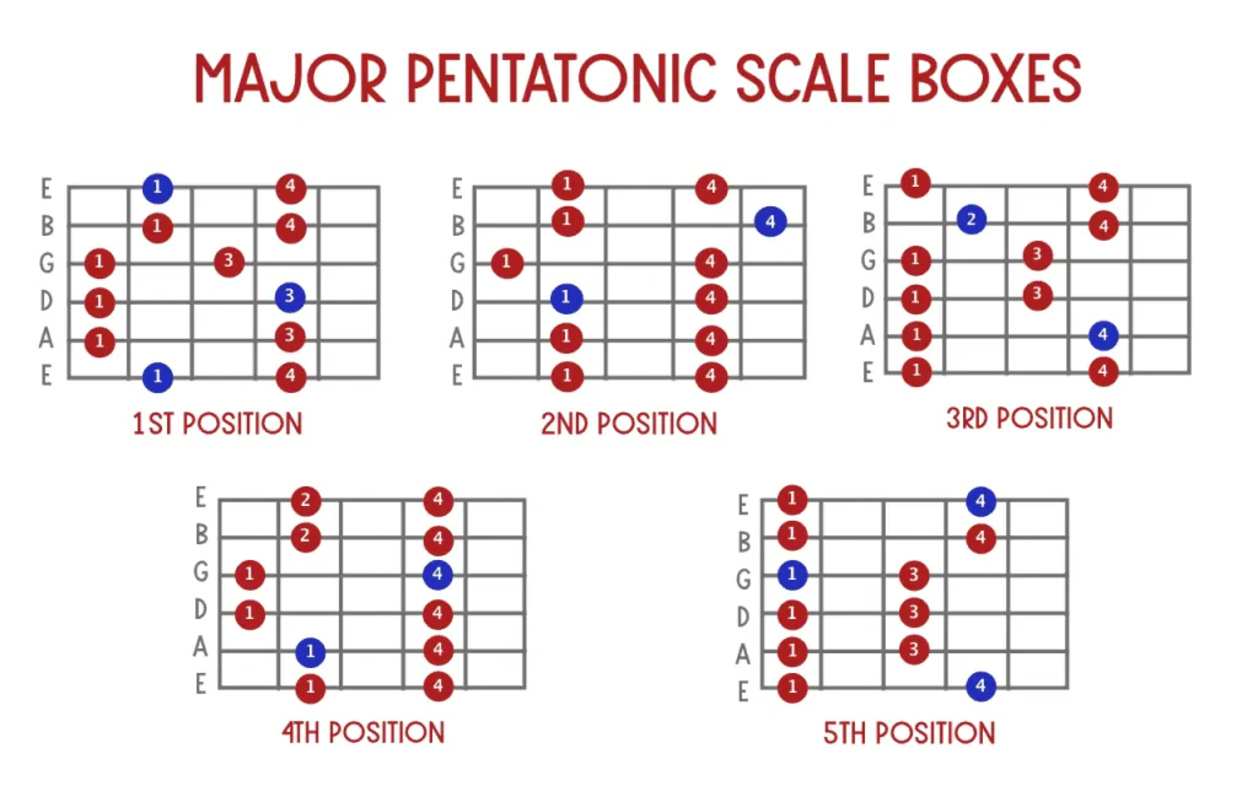Home>Instruments>Guitar>How To Play Pentatonic Scales On Guitar


Guitar
How To Play Pentatonic Scales On Guitar
Published: February 14, 2024
Learn how to play pentatonic scales on guitar and improve your soloing skills. Master the essential techniques for playing guitar scales.
(Many of the links in this article redirect to a specific reviewed product. Your purchase of these products through affiliate links helps to generate commission for AudioLover.com, at no extra cost. Learn more)
Table of Contents
Introduction
Playing the guitar is a fulfilling and enriching experience. Whether you're a novice or an experienced player, mastering the art of playing pentatonic scales can elevate your musical prowess to new heights. The pentatonic scale is a fundamental building block in the world of guitar playing, and understanding how to navigate its patterns and positions is essential for any guitarist looking to expand their repertoire.
In this comprehensive guide, we will delve into the intricacies of pentatonic scales and explore how to play them on the guitar. From understanding the theory behind pentatonic scales to mastering different positions and techniques, this article will equip you with the knowledge and skills needed to incorporate these captivating scales into your playing.
Whether you're drawn to the soulful sounds of blues, the electrifying riffs of rock, or the melodic stylings of jazz, the versatility of pentatonic scales makes them a valuable asset for any guitarist. By the end of this guide, you'll be well on your way to unlocking the full potential of the pentatonic scale and infusing your playing with a newfound sense of creativity and expression. So, grab your guitar, tune up, and let's embark on this musical journey together.
Understanding Pentatonic Scales
Before diving into the practical aspects of playing pentatonic scales on the guitar, it’s essential to grasp the foundational concepts behind these versatile musical constructs. The term “pentatonic” originates from the Greek words pente, meaning “five,” and tonos, meaning “tone.” As the name suggests, pentatonic scales consist of five notes per octave, offering a condensed yet melodically potent framework for musical expression.
One of the defining characteristics of pentatonic scales is their inherent versatility and compatibility with various musical genres. From blues and rock to country and jazz, pentatonic scales serve as a universal language for guitarists, enabling them to craft soul-stirring melodies and captivating improvisations.
Within the realm of pentatonic scales, two primary variants reign supreme: the major pentatonic scale and the minor pentatonic scale. The major pentatonic scale exudes a bright and uplifting quality, often associated with cheerful melodies and harmonious compositions. On the other hand, the minor pentatonic scale evokes a sense of depth, melancholy, and raw emotion, making it a staple in the arsenal of guitarists seeking to convey poignant narratives through their music.
Understanding the intervals that comprise these scales is pivotal for navigating their sonic landscapes. The intervals of a minor pentatonic scale, for instance, typically follow a pattern of root (tonic), minor third, perfect fourth, perfect fifth, and minor seventh. Conversely, a major pentatonic scale features intervals such as root (tonic), major second, major third, perfect fifth, and major sixth. Familiarizing oneself with these intervallic structures forms the bedrock for fluently traversing the fretboard and crafting captivating musical phrases.
By internalizing the essence of pentatonic scales and their distinct variations, guitarists can harness their emotive potential and infuse their playing with a rich tapestry of tonal colors. With this foundational knowledge in place, we can now embark on a journey to explore the positions and mechanics of pentatonic scales on the guitar.
Positions of Pentatonic Scales on the Guitar
As a guitarist, familiarizing yourself with the various positions of pentatonic scales on the fretboard is a pivotal step toward unlocking a world of melodic possibilities. The guitar offers a unique layout that allows players to visualize and traverse scales in distinct patterns across the fretboard, empowering them to craft captivating solos and improvisations.
One of the most widely utilized systems for navigating pentatonic scales is the concept of “box shapes.” These box shapes, also known as fingerings or patterns, serve as foundational templates that facilitate the exploration of pentatonic scales in different regions of the fretboard. For instance, the minor pentatonic scale is often associated with five primary box shapes, each spanning a specific range of frets and strings. By mastering these box shapes, guitarists gain the ability to fluidly transition between positions, fostering seamless connectivity and creative freedom in their playing.
Moreover, understanding the interplay between these box shapes is crucial for comprehensive fretboard mastery. Guitarists can seamlessly link adjacent box shapes, enabling them to traverse the entirety of the fretboard with dexterity and finesse. This interconnected approach empowers players to break free from the confines of a single position, facilitating dynamic and expressive musical journeys across the guitar’s expanse.
Each box shape harbors its unique sonic characteristics, allowing guitarists to imbue their playing with diverse tonal textures and emotive nuances. Whether it’s the raw grit of the first position or the soaring expressiveness of the fifth position, each box shape offers a distinct sonic landscape waiting to be explored and harnessed.
By internalizing the positions and box shapes of pentatonic scales, guitarists can transcend the boundaries of traditional fretboard navigation, embarking on a sonic odyssey that transcends limitations and unlocks the full potential of the instrument. Armed with this knowledge, players can seamlessly transition to the next phase of our exploration: playing pentatonic scales in different keys.
Playing Pentatonic Scales in Different Keys
As a guitarist, the ability to fluidly navigate pentatonic scales in various keys is a hallmark of proficiency and musical versatility. The concept of transposing pentatonic scales to different keys opens a gateway to a vast array of musical landscapes, enabling players to adapt to diverse musical contexts and expand their improvisational prowess.
Transposing pentatonic scales involves shifting the scale’s root note to correspond with the desired key while retaining the scale’s intervallic structure. This fundamental process empowers guitarists to seamlessly integrate pentatonic scales into compositions and improvisations across a spectrum of musical keys, broadening their sonic palette and expressive capabilities.
One of the most effective approaches to mastering pentatonic scales in different keys is to internalize the scale’s intervallic relationships and visualize their patterns across the fretboard. By anchoring the scale’s root note in alignment with the desired key, guitarists can leverage the familiar box shapes and positions to effortlessly traverse the new tonal terrain, infusing their playing with a sense of fluidity and adaptability.
Furthermore, delving into the nuances of each key’s tonal characteristics empowers guitarists to harness the emotive potential of pentatonic scales within specific musical contexts. Whether navigating the introspective depths of E minor or channeling the exuberant spirit of G major, adeptly transposing pentatonic scales enables players to tailor their musical expressions with precision and artistry.
Expanding one’s proficiency in playing pentatonic scales across different keys fosters a deeper connection with the instrument and enhances musical fluency. It enables guitarists to seamlessly integrate these scales into diverse musical genres and improvisational settings, transcending limitations and embracing a boundless sonic landscape.
With a firm grasp of playing pentatonic scales in different keys, guitarists can embark on a journey to explore the techniques that elevate these scales from mere patterns to vehicles of emotive expression and musical storytelling.
Techniques for Mastering Pentatonic Scales
Mastering pentatonic scales on the guitar transcends rote memorization of patterns; it entails imbuing these scales with dynamic articulation, emotive phrasing, and expressive techniques. By incorporating a range of nuanced approaches, guitarists can elevate their pentatonic playing from mechanical exercises to captivating musical expressions.
One fundamental technique for infusing pentatonic scales with vitality is bending. Bending notes within the pentatonic scale adds a vocal-like quality to the guitar’s voice, enabling players to imbue their melodies with soul-stirring nuances and emotive depth. Whether executing subtle micro-bends or dramatic whole-step bends, mastering this technique unlocks a world of expressive possibilities within the confines of the pentatonic scale.
Another indispensable technique is vibrato, which imparts sustained notes with a shimmering, expressive quality. By applying controlled vibrato to sustained tones within the pentatonic scale, guitarists can imbue their playing with a heightened sense of emotion and resonance, captivating listeners with the evocative power of their phrasing.
Furthermore, incorporating slides and hammer-ons/pull-offs into pentatonic passages enhances their fluidity and agility, allowing players to navigate the scale with seamless transitions and dynamic flair. These legato techniques lend a sense of interconnectedness to the notes, fostering a smooth and expressive flow that transcends the mechanical delineations of the scale.
Exploring the realms of dynamics and articulation within pentatonic scales is equally paramount. By varying the intensity and attack of their playing, guitarists can imbue the scale with a rich tapestry of tonal textures, from delicate whispers to searing crescendos. Additionally, tasteful employment of staccato and legato articulations within the scale’s framework adds depth and character to the musical phrases, enriching the overall sonic narrative.
Moreover, integrating bends, vibrato, slides, and other expressive techniques within pentatonic scales fosters a sense of individuality and musicality, enabling guitarists to carve out their distinctive voice within the confines of this foundational framework. By honing these techniques, players can transcend the technicalities of scale patterns, breathing life and emotion into their musical expressions.
Armed with these expressive techniques, guitarists can harness the full emotive potential of pentatonic scales, transforming them from static patterns into vehicles of profound musical storytelling and evocative improvisation.
Conclusion
Congratulations on embarking on this enriching journey through the realm of pentatonic scales on the guitar. By delving into the intricacies of these foundational musical constructs, you’ve equipped yourself with a versatile toolkit for crafting captivating melodies, improvisations, and musical expressions.
From grasping the theoretical underpinnings of pentatonic scales to mastering their positions and navigating them across different keys, you’ve gained a comprehensive understanding of how to harness the emotive potential of these scales. By internalizing the intervallic structures and visualizing the box shapes across the fretboard, you’ve laid the groundwork for seamless fretboard navigation and creative exploration.
Moreover, by honing expressive techniques such as bending, vibrato, slides, and dynamic articulations, you’ve transcended the confines of scale patterns, infusing your playing with a sense of individuality and emotive depth. These techniques have empowered you to breathe life and soul into the pentatonic scales, transforming them from mere patterns into vehicles of profound musical storytelling and emotive expression.
As you continue on your musical odyssey, remember that mastery is a journey, not a destination. Embrace each practice session and exploration of pentatonic scales as an opportunity for growth and self-expression. Whether you’re drawn to the bluesy laments of the minor pentatonic scale or the uplifting resonance of the major pentatonic scale, let your guitar be the vessel through which you channel your emotions and narratives.
By integrating the knowledge, techniques, and creative spirit cultivated in this guide, you’re poised to embark on a musical voyage filled with boundless possibilities. Embrace the versatility and expressive power of pentatonic scales, and allow them to serve as the springboard for your musical endeavors, whether in the studio, on stage, or in the solace of your practice space.
So, pick up your guitar, let your fingers dance across the frets, and immerse yourself in the captivating world of pentatonic scales. Unleash your creativity, hone your craft, and let the timeless allure of these scales fuel your musical passion and innovation.











